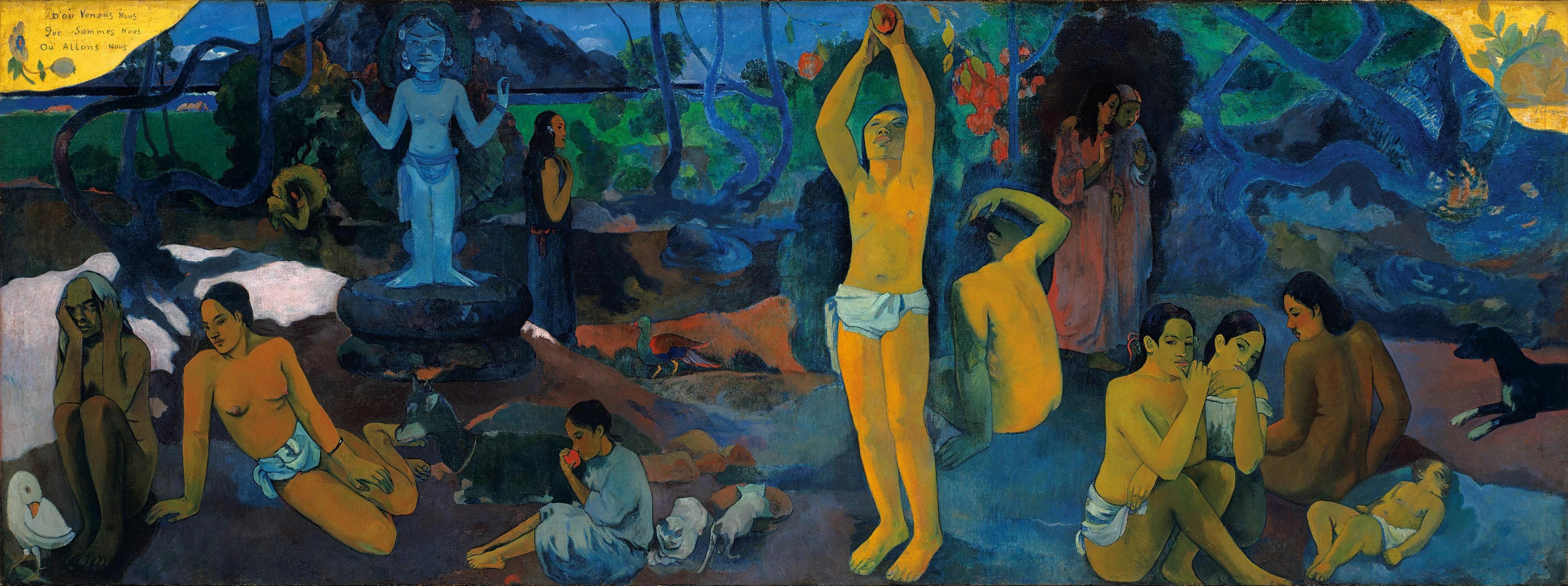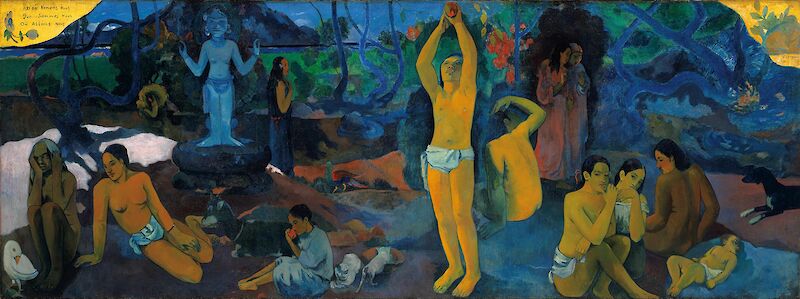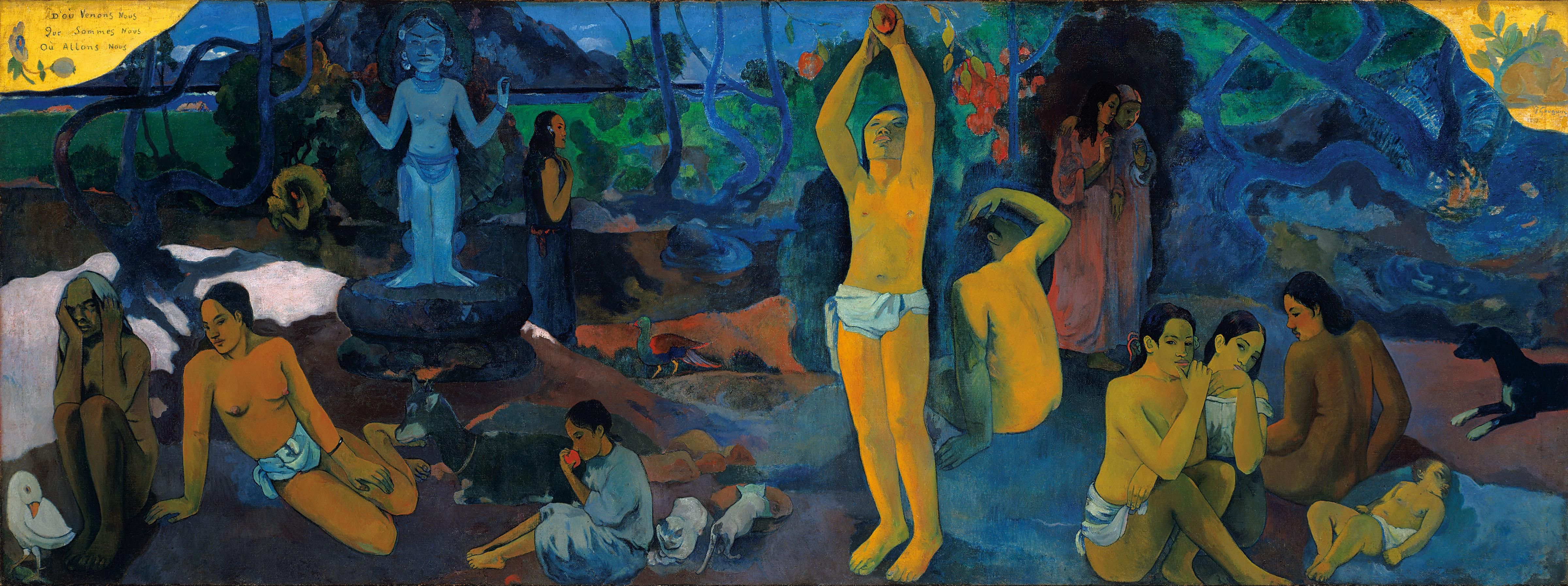


In the winter of 1897, Paul Gauguin set down his brush, walked up a hill near his home in Tahiti and swallowed a huge amount of arsenic. The painting he completed before this suicide expressed his personal gospel, a dream-state allegory spanning the largest canvas of his career.
The years leading up to December of 1897 had been rough for Gauguin. During his time on the Caribbean island of Martinique he contracted long-running cases of dysentery and malaria, he walked with a limp from a poorly healed ankle, broken in a fight five years earlier, and was exhausted from battling syphilis and its brutal treatment regime. His reputation in Paris was blighted after leaving his wife, his paintings weren't selling, and in 1897 his estranged daughter Aline died of pneumonia, leaving Gauguin fixated on their lost relationship. Finally, running out of money in Tahiti after a failed building project, Gauguin constructed a massive canvas, and poured his last great energy into an allegorical diorama describing destiny, the futility of language and death.
Gauguin awoke, vomiting. The arsenic had failed to kill him. In later letters, Gauguin described Where Do We Come From? What Are We? Where Are We Going? saying:
“It is a canvas about five feet by twelve. The two upper corners are chrome yellow, with an inscription on the left, and my name on the right, like a fresco on a golden wall with its corners damaged.
“To the right, below, a sleeping baby and three seated women. Two figures dressed in purple confide their thoughts to each other. An enormous crouching figure which intentionally violates the perspective, raises its arm in the air and looks in astonishment at these two people who dare to think of their destiny. A figure in the center is picking fruit. Two cats near a child. A white goat. An idol, both arms mysteriously and rhythmically raised, seems to indicate the Beyond. A crouching girl seems to listen to the idol. Lastly, an old woman approaching death appears reconciled and resigned to her thoughts. She completes the story. At her feet a strange white bird, holding a lizard in its claw [sic], represents a futility of words.
“The setting is the bank of a stream in the woods. In the background the ocean, and beyond the mountains of a neighboring island. In spite of changes of tone, the landscape is blue and Veronese green from one end to the other. The naked figures stand out against it in bold orange.
“If anyone said to the students competing for the Rome Prize at the Ecole des Beaux-Arts, the picture you must paint is to represent Where Do We Come From? What Are We? Where Are We Going? what would they do? I have finished a philosophical work on this theme, comparable to the Gospels. I think it is good.”
“I worked day and night that whole month in an incredible fever. Lord knows it is not done like a Puvis de Chavannes: sketch after nature, preparatory cartoon, etc. It is all done from imagination, straight from the brush, on sackcloth full of knots and wrinkles, so the appearance is terribly rough.
“They will say it is careless, unfinished. It is true that one is not a good judge of one’s own work, nevertheless I believe that this canvas not only surpasses all my previous work, but that I will never do anything better or even like it. Before dying I put into it all my energy, a passion so painful, in terrible circumstances, and a vision so clear, needing no correction, that the hastiness disappears and life surges up. It doesn't smell of the model, of conventional techniques and the so-called rules from all of which I have always liberated myself, though sometimes with trepidation . . .
“I look at it incessantly and (I admit) I admire it. The more I study it, the more I realize its enormous mathematical faults, which I will not correct at any price. The painting will stay as it is as a sketch, if you wish.
“But there is also this question which perplexes me: Where does the execution of a painting begin, and where does it end? At the very moment when the most intense emotions fuse in the depths of one’s being, at the moment when they burst forth and issue like lava from a volcano, is there not something like the blossoming of the suddenly created work, a brutal work, if you wish, yet great, and superhuman in appearance? The cold calculations of reason have not presided at this birth; who knows when, in the depths of the artist’s soul the work was begun unconsciously perhaps?”
...
Got questions, comments or corrections about Where Do We Come From? What Are We? Where Are We Going?? Join the conversation in our Discord, and if you enjoy content like this, consider becoming a member for exclusive essays, downloadables, and discounts in the Obelisk Store.
